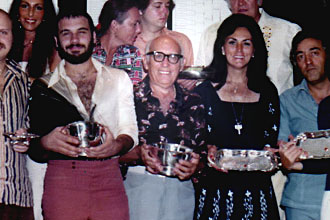|
| Magriel's NYT Columns |

Arthur Dickman (center) was a winner at the
Palm Bay Club in Miami in October 1977. Often in backgammon the advantage changes hands suddenly. Indeed, every backgammon player can recall situations in which a sound game plan was destroyed by a single unfortunate roll. Such disasters, however, can sometimes be averted by foresight and skillful play.
Arthur Dickman demonstrated this ability last weekend at the Florida State Championships, in Orlando. Dickman, a veteran of many year’s play at New York’s Mayfair Club, now lives in Florida. Known as a tough and resourceful competitor, he has placed in numerous tournaments. He was the finalist in both the 1975 International Grandmasters and the 1976 World Championship.
The diagrammed position is taken from an early round between Dickman (Black) and Van Vandivier (White). White has already doubled, but Black now has excellent chances despite having six men in White’s home board. Indeed, precisely because Black holds two points deep within White’s home board, White will have great difficulty bearing off safely. This “backgame” strategy gives Black good prospects of later hitting White and then winning the game. Nevertheless, back games must be considered inherently dangerous — they contain many pitfalls that can easily lead to being gammoned.
|
| Black to play 4-3. |
Dickman recognized the danger and took steps to avoid it. He correctly played 8/5, 6/2, in order to keep a spare man on the 8-point. The precaution “saves” 6’s — that is, it keeps a 6 in reserve, so that Black cannot be forced to give up the 24-point next turn.
Note that Black is not concerned about temporarily weakening his home-board position. The critical shots that White may leave will probably not come until later. (Only a 5-4 leaves an immediate shot.) Thus Black should have ample time to rebuild his position for a successful back game.
Dickman’s skillful playing enabled him to win this particular game, but Vandivier won the match. After this upset, Vandivier continued winning and captured the title.
Rollout
 Tom Keith 2013 |
|
Money play Black owns 2-cube Black rolls 4-3 1296 games with VR Checker play: 2-ply Cube play: 3-ply Red |
| 4-3: | Game | G | BG | Equity | ||||
| 1 | 8/5, 8/4 |
W L |
.3376 .6624 |
.0091 .4214 |
.0003 .0891 | −0.6689 |

| |
| 2 | 8/5, 6/2 |
W L |
.3393 .6607 |
.0053 .4018 |
.0003 .1032 | −0.6690 | (0.0001) |

|
|

